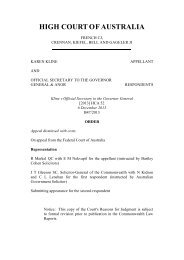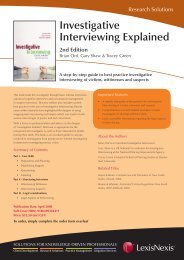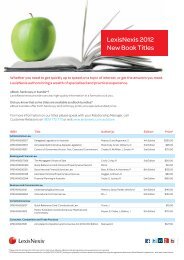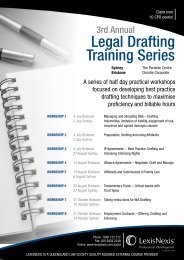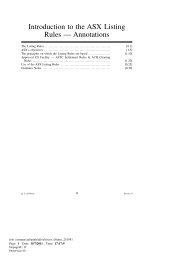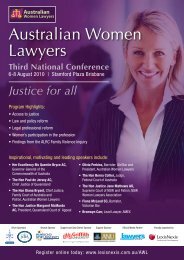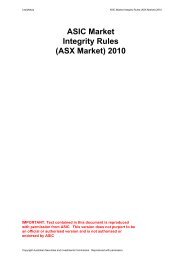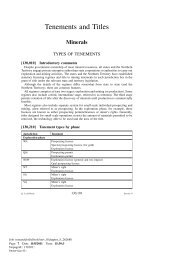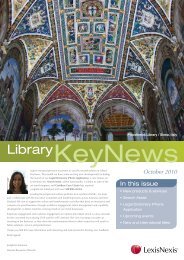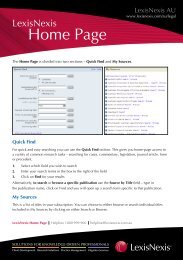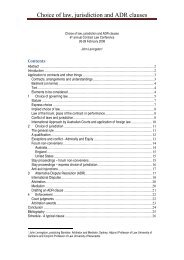Torts: Cases and Commentary - LexisNexis
Torts: Cases and Commentary - LexisNexis
Torts: Cases and Commentary - LexisNexis
You also want an ePaper? Increase the reach of your titles
YUMPU automatically turns print PDFs into web optimized ePapers that Google loves.
Authors: Bill Madden & Janine McIlwraith<br />
Edition: 1<br />
Web:<br />
http://www.lexisnexis.com.au/aus/products/documents/Madden_Australian_Medical_Liability_Prac.pdf<br />
Updated as at beginning of September 2011.<br />
Readers are invited to email suggestions on updates to Bill Madden:<br />
bill.madden@slatergordon.com.au<br />
Table of contents<br />
Click chapter name to jump to updates<br />
1 Introduction<br />
2 Duties Regarding Informed consent<br />
3 Duties Regarding Treatment<br />
4 Duties to Third Parties<br />
5 Duties to Disclose Error<br />
6 Vicarious Liability <strong>and</strong> Non Delegable Duties<br />
7 Breach of Duty in Informed Consent <strong>Cases</strong><br />
8 Breach of Duty in Treatment <strong>Cases</strong><br />
9 Special Protections<br />
10 Causation in Informed Consent <strong>Cases</strong><br />
11 Causation in Treatment <strong>Cases</strong><br />
12 Loss of Chance<br />
13 Contributory Negligence<br />
14 Wrongful Birth Claims <strong>and</strong> Damages<br />
15 Intentional <strong>Torts</strong><br />
1
2.3 Informed consent – Basic Principles<br />
The discussion in the text regarding recognition that people have the right<br />
to decide for themselves whether or not they will undergo medical<br />
treatment was reinforced by the outcome in Hunter <strong>and</strong> New Engl<strong>and</strong> Area<br />
Health Service v A [2009] NSWSC 761. The matter concerned refusal of<br />
medical treatment by an unconscious patient, based on an advance care<br />
directive stating the patient's desire to refuse certain treatments. The court<br />
was required to determine whether the directive was a valid indication of<br />
patient's desire, whether the patient had capacity to decide to refuse<br />
treatment when directive made <strong>and</strong> confirmed the patient's right of selfdetermination<br />
even where withdrawal of treatment would have life<br />
threatening consequences.<br />
Following shortly after Hunter <strong>and</strong> New Engl<strong>and</strong> Area Health Service v A<br />
[2009] NSWSC 761 referred to above, the matter of Brightwater Care<br />
Group (Inc) v Rossiter [2009] WASC 229 addressed similar issues when<br />
considering the legal obligations of a medical service provider with<br />
responsibility for the care of a mentally competent quadriplegic patient<br />
who directed the medical service provider to discontinue provision of<br />
nutrition <strong>and</strong> general hydration. The court‘s reasons were consistent with<br />
the principle of patient autonomy or self-determination as to whether or<br />
not the patient will continue to receive medical treatment. See also<br />
Australian Captial Territory v JT [2009] ACTSC 105 which addressed<br />
consent to medical treatment in the context of the patient‘s wishes based<br />
on a delusional set of assumptions; <strong>and</strong> H Limited v J [2010] SASC 176.<br />
Advanced Arbor Services Pty Limited v Phung [2009] NSWSC 1331 is an<br />
unusual case focusing on issues going beyond medical treatment. It is<br />
included here as it included liability for misrepresentation under the Trade<br />
Practices Act 1974 (Cth) <strong>and</strong> the Fair Trading Act 1987 (NSW).<br />
Hammond v Heath [2010] WASCA 6 considers the extent of the duty to<br />
warn, in particular regarding the removal of materials (in this case, mesh)<br />
used during the course of surgery.<br />
Application of Justice Health; re a Patient [2011] NSWSC 432. Proposal to<br />
withhold aggressive therapy which has the effect of prolonging the<br />
patient's life; consent of incompetent patient to such treatment not<br />
required. Distinguishable from cases where invasive treatment otherwise<br />
constituting an assault is proposed. Note at [6]: No patient has a right to<br />
insist on being given any particular treatment. The patient's right is that<br />
the medical practitioner use reasonable professional care in the interests<br />
of the patient's health <strong>and</strong> wellbeing. A patient is not entitled to insist on<br />
being prescribed particular drugs or receiving particular treatment but to<br />
that treatment, which the medical practitioner, using reasonable care,<br />
judges is best for the patient in the circumstances.<br />
2.6 The court as the ultimate arbiter<br />
2
The discussion in the text regarding Rogers v Whitaker notes that the<br />
st<strong>and</strong>ard of care is not to be determined solely, or even primarily, by<br />
reference to the practice followed or supported by a responsible body of<br />
opinion in the profession. Marko v Falk [2008] NSWCA 293 at [76] – [79]<br />
briefly addressed the circumstances in which a court may substitute its<br />
own opinion in the following terms: ‗Mr Neil submitted that Rogers v<br />
Whitaker supported the proposition that if all members of a particular<br />
profession were doing something that was not in accordance with what<br />
the Court considered to be careful practice, then the Court should say so.<br />
That submission was pitched at such a high level of generality as to be<br />
meaningless. It fails to recognise the careful distinction all members of the<br />
High Court drew in Rogers v Whitaker between diagnosis <strong>and</strong> treatment,<br />
<strong>and</strong> warning of risks. Mr Neil did not suggest any sensible route by which<br />
the Court could impose a view as to careful practice contrary to the<br />
medical opinions called on both parties’ behalves. Mr Neil could not refer<br />
the Court to any case since (or before) Rogers v Whitaker in which the<br />
court had taken the course he propounded in a case which involved<br />
clinical judgment in an operational context……In my view this was a case<br />
where the plurality view in Rogers v Whitaker as to the often decisive role<br />
professional opinion may play has strong resonance.‘<br />
Return to table of contents<br />
3
3.9 Duty under statute<br />
In the context of possible claims against medical practitioners under the<br />
Trade Practices Act 1974 (Cth), see Kowalczuk v Accom Finance [2008]<br />
NSWCA 343. The court followed Shahid v Australian College of<br />
Dermatologists [2008] FCAFC 72; (2008) 168 FCR 46.<br />
3.24 Qualifications <strong>and</strong> experience<br />
<br />
Imbree v McNeilly [2008] HCA 4. Consideration of aspects of Cook v Cook;<br />
Duty of care in the context of special relationship between plaintiff <strong>and</strong><br />
defendant. Note the passing reference to the implications of this decision<br />
in at Le Brun v Joseph [No 2] [2010] WASCA 52 at [183].<br />
3.32 Rural v city locations<br />
<br />
Richards & Ors v Rahilly & Anor [2005] NSWSC 352 at [145]: Rural<br />
practice may be a relevant circumstance in determining adequate care, in<br />
that access to sophisticated equipment is not as readily available as it<br />
would be in the city.<br />
Medico legal examinations<br />
Basha v Vocational Capacity Centre Pty Ltd [2009] NSWCA 409:<br />
Aggravation of shoulder injuries during vocational assessment; content of<br />
duty.<br />
Kilvington v Grigg & Ors [2010] QDC 496: Medical practitioner – duties to<br />
patient – certificate for application to superannuation fund – whether duty<br />
to provide – whether damages suffered.<br />
Drug rehabilitation<br />
<br />
Swanson v Kedesh Rehabilitation Services Ltd [2010] NSWCA 25: Drug<br />
rehabilitation program. No duty to ensure a particular result (the taking of<br />
medication before leaving facility); only to take reasonable care for the<br />
safety of its residents (at [43]).<br />
4
Medical Centres<br />
<br />
CS v Biedrzycka & Ors [2010] NSWSC xx: Medical Centre. Duty exists on<br />
the part of medical centre, in respect of the maintenance of accurate<br />
medical records capable of ensuring ready contact with a patient (at [41],<br />
[49]).<br />
Evidence on breach of duty & the like<br />
<br />
KF By Her Tutor RF v Royal Alex<strong>and</strong>ra Hospital for Children known as the<br />
Children's Hospital Westmead <strong>and</strong> Anor [2011] NSWSC 399. More in the<br />
nature of a procedural ruling, the court made an order pursuant to Rule<br />
31.24(2)(c) Uniform Civil Procedure Rules 2005, that a facilitator attend a<br />
reconvened breach of duty experts' conference.<br />
Return to table of contents<br />
5
4.1 Duties to third parties<br />
<br />
<br />
Glennie v Glennie [2009] NSWSC 154. As noted in the text, in Sullivan v<br />
Moody [2001] HCA 59; (2001) 207 CLR 562 the High Court considered<br />
whether medical practitioners, social workers <strong>and</strong> departmental officers<br />
involved in investigating <strong>and</strong> reporting upon allegations of child sexual<br />
abuse owed a duty of care to suspects. The court concluded that no such<br />
duty existed. Glennie v Glennie is an interlocutory decision addressing<br />
only a limitation period extension, but it foreshadows a claim against a<br />
medical practitioner by a sexual assault victim. It is alleged that the<br />
medical practitioner failed in his statutory duty to report sexual abuse of<br />
which he was aware, thereby allowing it to continue such that the victim<br />
suffered further damage.<br />
Chahoud v Koleda [2008] NSWSC 1060; (2007-2008) 72 NSWLR 740. A<br />
medical practitioner has no duty to a beneficiary of the will of a deceased<br />
patient in relation to advice to a court regarding the deceased‘s capacity<br />
<strong>and</strong> has the benefit of witness immunity for the contents of letters<br />
provided to a court or legal practitioner on the capacity of a deceased<br />
patient to execute a will.<br />
Privacy & Disclosure: Concerns about tensions between patient privacy<br />
<strong>and</strong> legal or ethical obligations to disclose to third parties who may be<br />
harmed have been addressed in the area of genetic information. The<br />
National Health <strong>and</strong> Medical Research Council (NHMRC), in cooperation<br />
with the Office of the Privacy Commissioner (OPC), have released new<br />
guidelines to assist health practitioners in making decisions about<br />
disclosing genetic information to their patient‘s genetic relatives. The new<br />
guidelines permit medical practitioners to disclose information to a genetic<br />
relative of the patient without the patient's consent, but only in situations<br />
where they reasonably believe that disclosure is necessary to lessen or<br />
prevent a serious threat to the life, health or safety of the patient's relative.<br />
The use <strong>and</strong> disclosure of genetic information to a patient‘s genetic<br />
relative under Section 95AA of the Privacy Act 1988 (Cth) – Guidelines for<br />
health practitioners in the private sector‘ are available for download at:<br />
http://www.nhmrc.gov.au/publications/synopses/e96syn.htm<br />
4.8 Psychiatric patients causing loss or injury to others<br />
Gray v Thames Trains & Ors [2009] UKHL 33. Man, suffering post<br />
traumatic stress disorder from earlier incident, not able to recover<br />
compensation for consequences of his later knife killing of a drunken<br />
pedestrian. Illegality defence.<br />
Simon <strong>and</strong> Anor v Hunter <strong>and</strong> New Engl<strong>and</strong> Area Health Service [2009]<br />
NSWSC 758 is an interlocutory decision only (regarding the availability of a<br />
6
jury trial) but arises from a claim in that a psychiatric patient was released<br />
from hospital into care of friend for road journey from Taree to Victoria <strong>and</strong><br />
the patient killed the friend during the journey. The claim will be one by<br />
relatives of the deceased for damages against Area Health Service.<br />
The Quadriplegic Centre Board of Management v McMurtrie [2009] WASCA<br />
173. A decision considering the duty of an institution to warn staff of the<br />
risk of injury from a patient with a history of violence. The claim failed on<br />
causation grounds.<br />
4.20 Normative causation<br />
Adams by her next friend O'Grady v State of New South Wales [2008]<br />
NSWSC 1257. Alleged breach of duty by State in providing plaintiff with<br />
access to knife with which she stabbed <strong>and</strong> killed a teacher. As to<br />
causation see [113]ff.<br />
Return to table of contents<br />
7
5.19 Ethical framework<br />
<br />
<br />
For an interesting discussion on the possible clinical benefit to the patient<br />
of an early disclosure of an adverse event, see A Allan & D McKillop, The<br />
health implications of apologizing after an adverse event, International<br />
Journal for Quality in Health Care 5 February 2010.<br />
Similar ethical obligations are reflected in 6.3.4 <strong>and</strong> 6.3.5 of Good Medical<br />
Practice: A Code of Conduct for Doctors in Australia adopted by the<br />
Medical Board of Australia<br />
www.medicalboard.gov.au/documents/default.aspx?record=WD10%2F12<br />
77&dbid=AP&chksum=eNjZ0Z%2FajN7oxjvHX...<br />
<br />
The Council of Australian Governments (COAG), at its meeting of 26 March<br />
2008, signed an Intergovernmental Agreement on the health workforce.<br />
This agreement led to the creation of a single national registration <strong>and</strong><br />
accreditation system for ten health professions: medical practitioners;<br />
nurses <strong>and</strong> midwives; pharmacists; physiotherapists; psychologists;<br />
osteopaths; chiropractors; optometrists; podiatrists <strong>and</strong> dentists (including<br />
dental hygienists, dental prosthetists <strong>and</strong> dental therapists). The scheme<br />
commenced on 1 July 2010. Section 141 of the Health Practitioner<br />
Regulation National Law 2009 (Act B) requires a registered health<br />
practitioner who reasonably believes that another registered health<br />
practitioner has behaved in a way that constitutes notifiable conduct,<br />
report that conduct to the relevant National Agency. In addition, a<br />
registered health practitioner who reasonably believes that a student has<br />
an impairment that, in the course of the student undertaking clinical<br />
training, may place the public at substantial risk of harm must report that<br />
conduct to the relevant National Agency. As to the width of notifiable<br />
conduct, the Bill settled on the following definition (s 140):<br />
notifiable conduct, in relation to a registered health practitioner,<br />
means the practitioner has:<br />
(a) practised the practitioner‘s profession while intoxicated by<br />
alcohol or drugs: or<br />
(b) engaged in sexual misconduct in connection with the practice of<br />
the practitioner‘s profession; or<br />
(c) placed the public at risk of substantial harm in the practitioner‘s<br />
practice of the profession because the practitioner has an<br />
impairment; or<br />
(d) placed the public at risk of harm because the practitioner has<br />
practised the profession in a way that constitutes a significant<br />
departure from accepted professional st<strong>and</strong>ards.<br />
8
Registered health practitioners excepted from making a m<strong>and</strong>atory<br />
notification include those employed or engaged by the insurer of<br />
the second health practitioner <strong>and</strong> those who formed the belief that<br />
notifiable conduct has occurred in the course of providing legal<br />
advice to one or other of the practitioners involved (s 141).<br />
For more information see www.ahpra.gov.au<br />
5.24 Apologies<br />
Queensl<strong>and</strong>: The Civil Liability Act 2003 (Qld) was amended in<br />
September 2010, inserting section 72A-72D. The amendments<br />
extend apology protections, including in circumstances where there<br />
is an implied admission of fault.<br />
Return to table of contents<br />
9
6.1 Vicarious Liability & Non-Delegable duties – Introduction<br />
NB v Sydney South West Area Health Service [2010] NSWDC 172 at [122]<br />
– [124]: Sexual assault of a patient by a ward orderly could not on any<br />
basis be regarded as a mode, proper or improper, of undertaking the<br />
authorised acts involved in fulfilling the role of a ward orderly. The conduct<br />
could be regarded only as an independent criminal act for which the<br />
defendant Area Health Service was not vicariously liable.<br />
Transfield Services (Australia) v Hall; Hall v QBE Insurance (Australia)<br />
[2008] NSWCA 294. A non-medical decision which in part discusses<br />
whether there is a general doctrine in Australian law that a person has a<br />
non-delegable duty to ensure reasonable care taken by an independent<br />
contractor employed to engage in an extra-hazardous or inherently<br />
dangerous activity; whether there is scope for extending concept of nondelegable<br />
duties beyond existing categories <strong>and</strong> the relevance of factors of<br />
control <strong>and</strong> vulnerability to finding of non-delegable duty.<br />
See also: Leighton Contractors Pty Ltd v Fox; Calliden Insurance Limited v<br />
Fox [2009] HCA 35<br />
Return to table of contents<br />
10
7.9 Material risks<br />
<br />
<br />
<br />
Coombe v Katsaros [2011] SASC 93. An action in negligence, regarding a<br />
plaintiff who suffered flexion contractures of little fingers due to<br />
Dupuytren's disease. For the purpose of releasing the contractures, the<br />
defendant performed separate operations on left <strong>and</strong> right h<strong>and</strong>s.<br />
Following those operations plaintiff developed pain in his h<strong>and</strong>s <strong>and</strong><br />
flexion contractures of his ring <strong>and</strong> little fingers, such that his little fingers<br />
were later amputated by another surgeon. In bringing his claim, the<br />
plaintiff alleged that the post-operative contractures were caused by<br />
Complex Regional Pain Syndrome (CPRS) <strong>and</strong> the Court was called upon to<br />
decide whether the defendant was negligent by reason of his failure to<br />
warn of the risks of CPRS, to warn of the risk of rapid contractures <strong>and</strong><br />
also whether defendant was negligent in failing to space the two<br />
operations further apart <strong>and</strong> in failing to advise the plaintiff to space the<br />
operations further apart. The plaintiff's claim failed <strong>and</strong> the action was<br />
dismissed. The Court did not accept that the risk of CRPS was a material<br />
one, nor that such a warning would have altered the decision of the<br />
plaintiff to undergo the surgery. Nor did the Court accept that the spacing<br />
of the two operations was causative of the outcome.<br />
Wallace v Ramsay Health Care Ltd [2010] NSWSC 518 at [49]: It is not the<br />
same thing to say that, if the plaintiff had been warned of the risk but<br />
would nonetheless have proceeded to have the surgery, the risk was<br />
therefore not material. In other words, the decision that a particular<br />
patient may take when warned of the risk is not necessarily coextensive<br />
with or conclusive of a determination of the materiality of that risk. A<br />
particular material risk may persuade some prospective surgical<br />
c<strong>and</strong>idates to proceed to surgery <strong>and</strong> take the risk, whilst others faced<br />
with the identical risk may not be prepared to do so. The inquiry at the<br />
breach stage is informed by the question of whether or not a reasonable<br />
patient in the position of the plaintiff would attach significance to the risk,<br />
not whether a reasonable patient in the position of the plaintiff would<br />
attach significance to the fact that the risk came home.<br />
Francis v Petros [2010] WADC 149. Interlocutory consideration in the<br />
context of a limitation period dispute, as to whether a cause of action<br />
based on failure to warn arises when the relevant surgery is carried out or<br />
when the risk materialises. Held at [30], actionable harm does not arise<br />
until the risk eventuates.<br />
7.16 Elective procedures<br />
Ormsby v Stewart & Ors [2009] QSC 200. Intraocular lens replacement<br />
surgery. Breach of duty & causation not found.<br />
7.20 Clinically indicated procedures<br />
11
Rooke v Minister for Health [2009] WASCA 27 on appeal from Rooke v<br />
Minister for Health [2008] WADC 6. Post-operative sensitivity - Dupuytren's<br />
contracture. Breach of duty & causation not found.<br />
Lentzner v Baumwol [2009] WADC 168. Hernia repair surgery; breach of<br />
duty not found.<br />
7.32 Breach of duty in informed consent cases – differing risks<br />
elsewhere<br />
G & C v Down [2008] SADC 135. A decision concerning failure to warn of<br />
the risks of failure of a sterilisation procedure. At [140] ff the court<br />
addresses differences between a surgeon's own rate <strong>and</strong> the general<br />
published failure rate. ‗[140] In my opinion, the Defendant failed to meet<br />
the st<strong>and</strong>ard required of him in that he did not make it clear that the<br />
numerical ratio of 1 in 2000 related to his experience. Using the st<strong>and</strong>ard<br />
of an ordinary skilled gynaecologist, such a practitioner would have made<br />
it clear. In my view, where the gynaecologist’s personal experience is<br />
conveyed in numerical terms, it is important that it be made clear to the<br />
patient that it refers the gynaecologist’s failure rate. The personal<br />
experience of the gynaecologist would be of great significance to the<br />
patient. [141] I am also of the opinion that where the numerical<br />
ratio of the gynaecologist’s personal failure rate is conveyed, either in<br />
response to questioning by the patient or being volunteered by the<br />
gynaecologist, then in order to provide a proper balance for the patient,<br />
the literature failure rate should be conveyed. The picture would not be<br />
complete otherwise.’<br />
On appeal as to causation see G, P A & C, P v Down [2009] SASC 217,<br />
where at [67] Anderson J did not disagree with the approach of the trial<br />
judge regarding breach of duty. An application for special leave to appeal<br />
to the High Court was refused: Gilchrist & Anor v Down [2010] HCATrans<br />
24<br />
Return to table of contents<br />
12
8.10 The ‗widely accepted‘ defence<br />
Sydney South West Area Health Service v Stamoulis [2009] NSWCA 153.<br />
The evidence of an expert is not inadmissible merely because he or she is<br />
materially interested in the proceedings. Such matters go to weight <strong>and</strong><br />
not admissibility. (For the retrial on this limited issue, see Stamoulis v<br />
Sydney South West Area Health Service [2010] NSWSC 585.)<br />
Hawes v Holley [2008] NSWDC 147. Consideration of alleged failure to<br />
treat patient by pharmacological means to avoid need for abdominal<br />
surgery, in circumstances where complications of the abdominal surgery<br />
later occurred.<br />
Vella v Permanent Mortgages Pty Ltd [2008] NSWSC 505. Consideration<br />
of regional variations in widely accepted practice: see [550] ff.<br />
Melchior <strong>and</strong> Ors v Sydney Adventist Hospital Ltd <strong>and</strong> Anor [2008] NSWSC<br />
1282. Negligence at common law not found, but in any event ‗widely<br />
accepted‘ defence capable of application: see [142] ff.<br />
MD v Sydney South West Area Health Service [2009] NSWDC 22 held that<br />
the ‗widely accepted‘ defence must be pleaded (in NSW) for a defendant to<br />
rely on the defence at trial. Confirmed on appeal in Sydney South West<br />
Area Health Service v MD [2009] NSWCA 343.<br />
Kocev v Toh [2009] NSWDC 169. Chiropractic treatment. Negligence at<br />
common law not found, but in any event ‗widely accepted‘ defence<br />
capable of application: see [80].<br />
Peterson v South Eastern Sydney Illawarra Area Health Service & Elliott<br />
[2010] NSWDC 114: Negligence at common law not found, but in any<br />
event ‗widely accepted‘ defence capable of application.<br />
Note: Mark Williams, DLA Phillips Fox, suggests that whilst South Australia‘s<br />
provision is similar to that of New South Wales, the other jurisdictions have a<br />
subtle but significant wording difference which may give rise to a different<br />
approach to that of the available defence, taken in New South Wales. See M<br />
Williams, Proving medical negligence across Australia, DLA Phillips Fox Health<br />
Law Bulletin May 2009.<br />
8.10 The irrational <strong>and</strong> other exceptions<br />
In the absence of a decision thus far in which a defendant has been found<br />
negligent <strong>and</strong> then has successfully called upon the widely accepted defence, it<br />
follows that the irrational exception has yet to be applied so as to overturn that<br />
defence.<br />
<br />
In Hope v Hunter <strong>and</strong> New Engl<strong>and</strong> Area Health Service [2009] NSWDC<br />
307, Levy SC DCJ, although not finding it necessary to apply the irrational<br />
exception, commented on the meaning of the exception as follows:<br />
13
o [174] The question arises as to what constitutes an irrational<br />
opinion. In this context I do not construe “irrational” to mean<br />
without reasons, although it can have that meaning. Rather, I<br />
construe it to refer to reasons that are illogical, unreasonable or<br />
based on irrelevant considerations. [175] I consider that at the<br />
forefront of a consideration of the reasoning of an opinion used to<br />
base a s 5O defence, the focus should be on the practical nature of<br />
the risk that attracted the duty of care <strong>and</strong> the consideration of<br />
patient safety concerning sources of potential intra-operative harm<br />
if reasonable precautions against the foreseeable risk of harm are<br />
not reasonably taken.<br />
8.34 Delayed diagnosis & misdiagnosis<br />
<br />
<br />
<br />
<br />
<br />
<br />
<br />
<br />
Mazza v Webb [2011] QSC 163. Endoscopy failing to diagnose a small<br />
bowel carcinoma. Extent of endoscopy not negligent but (at [43])<br />
reasonable care dem<strong>and</strong>ed that the endoscopist alert the referring doctor<br />
that the investigation had been limited.<br />
McKay v McPherson [2010] VCC 585. Failure to recognise that the plaintiff<br />
was unwell with symptoms of heart failure, secondary to undiagnosed<br />
cardiomyopathy.<br />
Peterson v South Eastern Sydney Illawarra Area Health Service & Elliott<br />
[2010] NSWDC 114. Allegation of delayed treatment following non union<br />
or mal union of fracture. Breach of duty not proven.<br />
Athanssiadis v Likos [2010] SADC 85. Breach of duty not proven, regarding<br />
failure to earlier treat gallstones hence avoid effects of gall bladder cancer.<br />
Causation not proven in any event.<br />
Le Brun v Joseph (No 2) [2010] WASCA 53. Severe headaches <strong>and</strong> later<br />
rupture of undiagnosed arteriovenous malformation (AVM). Whether<br />
headaches caused by AVM & whether negligence in not referring for CT<br />
scan of brain or to neurologist to investigate cause of headaches.<br />
Thompson v Haasbroek [2010] NSWSC 111. Failure to detect <strong>and</strong><br />
diagnose cervical radiculopathy.<br />
Davy -v- Minister for Health [2009] WASCA 170. Claim failed, alleging<br />
delayed arrangement for knee infection review by hospital.<br />
Spasovic v Sydney Adventist Hospital [2003] NSWSC 791. Claim alleging<br />
to exercise reasonable care in assessing <strong>and</strong> treating complaints made<br />
<strong>and</strong> symptoms exhibited in particular a headache, which were caused by a<br />
small cerebral haemorrhage from an arterio-venous malformation (AVM‖).<br />
Discharge from hospital without the small cerebral haemorrhage or the<br />
AVM having been diagnosed.<br />
8.62 ff Surgical errors<br />
14
Burton v Allen [2010] NSWDC 265. Incomplete carpal tunnel release -<br />
Anomaly in position of median nerve - Whether apparent to defendant in<br />
course of st<strong>and</strong>ard carpal tunnel release - Whether appropriate means of<br />
check that nerve fully decompressed adopted - St<strong>and</strong>ard of post operative<br />
care provided - If inadequate whether causative of plaintiff‘s ongoing pain<br />
<strong>and</strong> disability.<br />
Hawkesbury District Health Service Limited v Chakar [2010] NSWCA 320.<br />
Claim in relation to varicose vein procedure. Rehearing ordered.<br />
Harris v Bellemore [2010] NSWSC 176. Leg lengthening procedures;<br />
whether cosmetic surgery. Primacy of patient autonomy in determining<br />
scope of duty warn, whether plaintiff would have chosen to undergo<br />
surgery in any event. See also the appeal decision regarding two damages<br />
issues, Harris v Bellemore [2011] NSWCA 196.<br />
Wells v Juengling [2008] WADC 18 was overturned on appeal (pending<br />
retrial) in Juengling v Wells [2009] WASCA 125.<br />
Marko v Falk [2007] NSWSC 14 has now been considered by the New<br />
South Wales Court of Appeal as Marko v Falk [2008] NSWCA 293.<br />
8.74 Failure to follow up<br />
<br />
Young v CAACI & Ors [2008] NTSC 47. CAACI had a responsibility to put<br />
administrative procedures in place to deal with patients who fail to attend<br />
appointments relating to potentially serious conditions, in this case being<br />
suspected ischaemic heart disease. As there was no system implemented<br />
at the time, breach of duty on the part of CAACI. See below for comment<br />
regarding contributory negligence.<br />
8.76 Mental health care<br />
Adams by her next friend O'Grady v State of New South Wales [2008]<br />
NSWSC 1257. Alleged breach of duty by State in providing plaintiff with<br />
access to knife with which she stabbed <strong>and</strong> killed a teacher.<br />
8.116 Birth trauma - Foetal<br />
<br />
Boustead v North West Strategic Health Authority [2008] EWHC B11 (QB).<br />
Claim in relation to care provided by a young mother during her pregnancy<br />
<strong>and</strong> labour <strong>and</strong> to her baby during the neonatal period. The child<br />
subsequently suffered from cerebral palsy with moderate learning<br />
disability, dysarthria <strong>and</strong> right sided hemiplegia. Experts agreed that the<br />
child suffered brain injury due to an intraventricular haemorrhage <strong>and</strong> the<br />
serious consequences which flowed from it.<br />
15
Do (an infant) by his next best friend Lan Thi Hoang & Anor -v- King Edward<br />
Memorial & Princess Margaret Hospitals Board [2008] WADC 118. Claim<br />
in relation to whether the plaintiff (before birth) was adequately monitored<br />
<strong>and</strong> whether intrauterine resuscitation <strong>and</strong>/or earlier delivery ought to<br />
have occurred; causation as to whether alleged negligence lead to<br />
prolongation of hypoxic event <strong>and</strong> caused or contributed to injury in the<br />
form of cerebral palsy of infant plaintiff.<br />
8.126 Birth trauma - Maternal<br />
McLennan v McCallum [2010] WASCA 45. Appellant born with severe<br />
encephalopathy. Whether obstetrician or nursing staff negligent;<br />
causation, turns on own facts. Appeal refused. (First instance decision<br />
discussed in the text at [8.118].)<br />
Hassan v The Minister for Health [No 2] [2008] WASCA 149. Claim arising<br />
from induced labour following foetal death in utero. Issues included<br />
consideration of whether informed consent was given to participate in a<br />
trial of use of a drug Misoprostal to induce labour <strong>and</strong> the adequacy of<br />
management of the induction of labour, leading to hysterectomy.<br />
Sernack v Leader NSW District Court unreported, 23 April 2008.<br />
2005/5676 per McLoughlin DCJ. Claim concerning injury/laceration to the<br />
rectal mucosa, internal anal sphincter <strong>and</strong> external anal sphincter, leading<br />
to recto-vaginal fistula.<br />
8.143 Dental care<br />
<br />
R v Pegios [2008] NSWDC 104. An unusual matter involving prosecution of<br />
a dentist for the manslaughter of a patient, arising from the administration<br />
of sedatives.<br />
8.154 Burden of taking precautions<br />
<br />
Jeffs v Rio Tinto Limited <strong>and</strong> Anor [2010] NSWSC 1046. An example of an<br />
approach taken by the court to the burden of taking precautions analysis,<br />
where a number of trucks would require modification at a total cost in the<br />
order of $850,000. The court noted the cost in the context of the total<br />
value of the equipment <strong>and</strong> the overall size of the defendant company. The<br />
court also noted that such a recommendation had been made in a risk<br />
assessment study..<br />
Return to table of contents<br />
16
9.12 Wednesbury unreasonableness<br />
Allianz Australia Insurance Ltd v Roads <strong>and</strong> Traffic Authority of New South<br />
Wales; Kelly v Roads <strong>and</strong> Traffic Authority of New South Wales [2010]<br />
NSWCA 328. A non-medical case which in part considered section 43A<br />
Civil Liability Act 2002 NSW at [74]ff.<br />
Precision Products (NSW) Pty Limited v Hawkesbury City Council [2008]<br />
NSWCA 278. A non-medical case which in part considered section 43A<br />
Civil Liability Act 2002 NSW <strong>and</strong> at [175] ff: ‗A further important<br />
consideration is the content of sub-s 43A(3) <strong>and</strong> the meaning of the<br />
phrase “so unreasonable that no authority having the functions of the<br />
authority in question could properly consider the act or omission to be a<br />
reasonable exercise of its function.” Such wording can be seen to have its<br />
source in what is often referred to as “Wednesbury unreasonableness”<br />
from Associated Provincial Picture Houses Limited v Wednesbury<br />
Corporation [1948] 1 KB 223 at 229-230. Regard could equally be had to<br />
the formulation of cognate concepts in Avon Downs Pty Limited v Federal<br />
Commission of Taxation [1949] HCA 26; 78 CLR 353 at 360; R v Connell;<br />
ex parte Hetton Bellbird Collieries Limited [1944] HCA 42; 69 CLR 407 at<br />
430; <strong>and</strong> Buck v Bavone [1976] HCA 24; 135 CLR 110 at 118-119.<br />
Cognate ideas are also found in the law attending the responsibility of<br />
company directors. The Court there focuses on whether decisions made by<br />
boards are made honestly in the interest of the company or are of a kind<br />
which no reasonable person could have reached: see Shuttleworth v Cox<br />
Brothers <strong>and</strong> Co (Maidenhead) Limited [1927] 2 KB 9 at 23-24; Peters’<br />
American Delicacy Co Ltd v Heath [1939] HCA 2; 61 CLR 457 at 481; <strong>and</strong><br />
Wayde v New South Wales Rugby League Limited [1985] HCA 68; 180<br />
CLR 459 at 469-470. While these are different areas of human<br />
endeavour, formulations of the kind used in these cases, whether it be in<br />
public law, the law of business or the law of torts are attempts to<br />
formulate more attenuated tests for legitimate activity than by reference<br />
to a fixed st<strong>and</strong>ard of reasonable care. Whether it is appropriate to<br />
describe s 43A as encapsulating the blunt expression of “gross<br />
negligence” is a matter for debate. However, it is plain that the drafter of s<br />
43A was attempting to ameliorate the rigours of the law of negligence.<br />
…...’<br />
9.18 Apologies<br />
<br />
Dovuro Pty Ltd v Wilkins [2003] HCA 51; 215 CLR 317. Consideration of<br />
the extent to which a court may interpret an apology or admission as<br />
determining liability or assisting in a determination of liability.<br />
9.21 Duty to rescue<br />
<br />
See Saving us from ourselves – The duty of care in negligence to prevent<br />
self-inflicted harm, by M Fordham (2010) 18 <strong>Torts</strong> Law Journal 22.<br />
17
R v Natalie Burns [2009] NSWDC 232. Consideration of an unusual<br />
circumstance under the criminal law, in which a duty to rescue may exist.<br />
See at [31]:<br />
o ‗Notwithst<strong>and</strong>ing the restraint which courts exercise in this area of<br />
the law, I am satisfied that while it is necessary for me to avoid<br />
engaging in judicial legislation by asserting a general principle<br />
analogous to section 155 of the Northern Territory Criminal Code<br />
Act, nonetheless on the facts in the present case I am satisfied that<br />
I can <strong>and</strong> should state the law of New South Wales to be as follows:<br />
―If a person voluntarily invites or permits potential recipients to<br />
attend his or her home for the purpose of a prohibited drug supply<br />
transaction where the drugs are to be consumed on the premises,<br />
<strong>and</strong> where such a recipient may be or become seriously affected by<br />
drugs to the point where his or her life may be endangered, the<br />
drug supplier has a duty to conduct himself toward the drug<br />
recipient without being grossly or criminally neglectful.‖ ‗<br />
Return to table of contents<br />
18
10.15 <strong>Cases</strong> regarding the exclusion of the plaintiff‘s evidence<br />
<br />
Neal v Ambulance Service of New South Wales [2008] NSWCA 346: See<br />
discussion at [40] – [42] regarding the practical effect of the exclusion:<br />
―Whatever the real purpose of the provision, the issue for determination is<br />
how a court is now to identify what course the plaintiff would have taken,<br />
absent negligence. That assessment might include evidence of the<br />
following: (a) conduct of the plaintiff at or about the relevant time; (b)<br />
evidence of the plaintiff as to how he or she might have felt about<br />
particular matters; (c) evidence of others in a position to assess the<br />
conduct of the plaintiff <strong>and</strong> his or her apparent feelings or motivations,<br />
<strong>and</strong> (d) other matters which might have influenced the plaintiff….Properly<br />
understood, the prohibition on evidence from the plaintiff about what he or<br />
she would have done is of quite limited scope. Thus, the plaintiff cannot<br />
say, “If I had been taken to hospital I would have agreed to medical<br />
assessment <strong>and</strong> treatment”. Indeed, as the Negligence Review<br />
recognised, such evidence would be largely worthless. However, the<br />
plaintiff might have explained such evidence along the following lines: “I<br />
recall on the trip to the police station that I began to fell less well; my state<br />
of inebriation was also diminishing; I began to worry about the pain in my<br />
head ….”…. That evidence (entirely hypothetical in the present case) would<br />
not be inadmissible. If accepted, it might provide a powerful reason for<br />
discounting any inference as to future conduct drawn from the past<br />
refusal of treatment. It would constitute evidence as to the plaintiff’s<br />
position, beliefs <strong>and</strong> fears. Because an inference would need to be drawn<br />
from that evidence, no doubt the court would take into account the likely<br />
response of a reasonable person in such circumstances. That is consistent<br />
with the Act requiring that the matter be determined “subjectively in the<br />
light of all relevant circumstances”.<br />
10.20 Other case examples<br />
<br />
<br />
<br />
Papa v Sullivan Nicolaides Pty Limited [2010] QSC 364. The defendant<br />
firm of medical pathologists monitored the INR levels of the plaintiff but<br />
did not tell her that her Warfarin levels were above the target range. The<br />
plaintiff went on to have a stroke. The plaintiff succeeded in her claim that<br />
the pathologists should have notified the plaintiff <strong>and</strong> her general<br />
practitioner, <strong>and</strong> on causation.<br />
Wallace v Ramsay Health Care Ltd [2010] NSWSC 518. Spinal surgery.<br />
Failure to warn of a material risk proven, however causation not proven as<br />
referable damage did not arise <strong>and</strong> plaintiff would not have refused the<br />
surgery in any event.<br />
Hookey v Paterno [2009] VSCA 48: Orthognathic surgery for correction of<br />
Class II malocclusion in 49 year old female smoker. Duty to warn of risk of<br />
adverse effect of proposed surgery & causation issue — whether patient<br />
would have undergone surgery if warned of risk.<br />
19
Kerr v Minister for Health [2007] WADC 61 has now been considered by the<br />
Western Australian Court of Appeal as Kerr v Minister for Health [2009]<br />
WASCA 32 ; appeal dismissed.<br />
Watson v Kailis [2008] WADC 95. Alleged failure to warn of risk of<br />
cosmetic procedures <strong>and</strong> post-operative complications. Trichloroacetic<br />
acid peel of the face ("TCA peel").<br />
Hansen v Babich [2006] WADC 189. Scarring to back. Whether necessary<br />
to warn of increased risk of scarring in the event of infection.<br />
Marko v Falk [2007] NSWSC 14 has now been considered by the New<br />
South Wales Court of Appeal as Marko v Falk [2008] NSWCA 293.<br />
Return to table of contents<br />
20
Amaca Pty Ltd v Ellis; The State of South Australia v Ellis; Millennium<br />
Inorganic Chemicals Ltd v Ellis [2010] HCA 5. Analysing epidemiological<br />
evidence, the High Court held that no inference of causation could be<br />
drawn that the exposure to asbestos was a probably cause of lung cancer<br />
when the plaintiff was also a smoker. Observing that a small percentage of<br />
cancer cases were probably caused by asbestos exposure to asbestos did<br />
not permit identification of whether an individual is one of that group.<br />
Given the small size of the statistical percentage, the observation did not,<br />
without more, support the drawing of an inference in this case. The<br />
decision may be contrasted with Workers Compensation (Dust Diseases)<br />
Bord of NSW v Smith Munro <strong>and</strong> Seymour [2010] NSWCA 19.<br />
Adeels Palace Pty Ltd v Moubarak; Adeels Palace Pty Ltd v Bou Najem<br />
[2009] HCA 48 at [55]: ‗At once it must be recognised that the legal<br />
concept of causation differs from philosophical <strong>and</strong> scientific notions of<br />
causation. It must also be recognised that before the Civil Liability Act <strong>and</strong><br />
equivalent provisions were enacted, it had been recognised that the "but<br />
for" test was not always a sufficient test of causation. But as s 5D(1)<br />
shows, the "but for" test is now to be (<strong>and</strong> has hitherto been seen to be) a<br />
necessary test of causation in all but the undefined group of exceptional<br />
cases contemplated by s 5D(2).’ {Footnotes omitted}<br />
Woolworths Limited v Strong & Anor [2010] NSWCA 282. Note at [48] the<br />
obiter consideration as to the effect of section 5D(1) Civil Liability Act<br />
2002 (NSW) on the concept of material contribution: ‗[48] Now, apart from<br />
the ―exceptional case‖ that section 5D(2) recognises, section 5D(1) sets<br />
out what must be established to conclude that negligence caused<br />
particular harm. That emerges from the words ―comprises the following<br />
elements‖ in the chapeau to section 5D(1). ―Material contribution‖, <strong>and</strong><br />
notions of increase in risk, have no role to play in section 5D(1). It well may<br />
be that many actions or omissions that the common law would have<br />
recognised as making a material contribution to the harm that a plaintiff<br />
suffered will fall within section 5D(1), but that does not alter the fact that<br />
the concepts of material contribution <strong>and</strong> increase in risk have no role to<br />
play in deciding whether section 5D(1) is satisfied in any particular case.‘<br />
See however the disagreement of Garling J in Peter Steven Benic v State of<br />
New South Wales [2010] NSWSC 1039 at [516].<br />
11.10 Causation principle legislation<br />
<br />
<br />
Hirst v Sydney South West Area Health Service [2011] NSWSC 664. Civil<br />
Liability Act 2002 (NSW) - whether s 5E (plaintiff always bears the onus of<br />
proof) is confined to legal onus - whether principle in Watts v Rake<br />
operative to claims under Civil Liability Act.<br />
Hollier v Sutcliffe [2010] NSWSC 279. Implanon insertion claim, causation<br />
issue as to chronic pain syndrome. Civil Liability Act 2002 (NSW) section<br />
5D(1) necessary condition test not met: see [212] – [213].<br />
21
Den Elzen v Harris [2008] WADC 106. Claim concerning management of<br />
hydrocephalus <strong>and</strong> whether outcome would have differed in any event.<br />
Note at [203]: ―However, this is in my view a case where the damage<br />
would be the very sort of thing that would be likely to occur in the event of<br />
breach, so that an evidentiary onus would fall on the defendant to show<br />
an absence of causation.‖<br />
Queen Elizabeth Hospital v Curtis [2008] SASC 344. Although not<br />
expressly addressing the provisions which provide that in determining<br />
liability for negligence the plaintiff always bears the onus of proving on the<br />
balance of probabilities, any fact relevant to the issue of causation, see<br />
detailed discussion of causation after the observations of Gaudron J in<br />
Bennett v Minister of Community Welfare.<br />
11.10 Causation – common law principles<br />
<br />
<br />
In the text at 11.11, the authors said it may be sufficient to establish<br />
causation that a defendant‘s breaches of duty materially increased the risk<br />
of injury to the plaintiff, <strong>and</strong> that risk materialised: see Flounders v Millar<br />
[2007] NSWCA 238, but contrast the remarks of Kieffel J in Roads <strong>and</strong><br />
Traffic Authority v Royal [2008] HCA 19 at [144]. In Sydney South West<br />
Area Health Service v Stamoulis [2009] NSWCA 153 per Ipp JA (Beazley<br />
<strong>and</strong> Giles JJA agreeing) the court held that a mere material increase in the<br />
risk of injury followed by the eventuation of the risk in question is<br />
insufficient to establish causation. The plaintiff must establish that it was<br />
probable that the risk created by the tortfeasor came home.<br />
Workers Compensation (Dust Diseases) Board of NSW v Smith, Munro &<br />
Seymour [2010] NSWCA 19. One factor can contribute to an outcome even<br />
though, relative to another factor, it has a minor effect. All that is required<br />
is that the effect be "material". Any assessment of this materiality is an<br />
evaluative judgment, <strong>and</strong> it was open upon the evidence to conclude that<br />
the exposure to asbestos was such a material factor: [72]. An ultimate<br />
finding of causation may be based on a number of inferences drawn from<br />
primary facts, which may cumulatively allow the ultimate finding to be<br />
made. It depends on the circumstances as to whether these inferences are<br />
available through the application of logic <strong>and</strong> commonsense, technical<br />
inquiry, or expert assessment. In circumstances where epidemiological<br />
studies cannot provide scientific certainty as to the probability of a<br />
material contribution, <strong>and</strong> further uncertainty surrounds the precise<br />
experience undergone by the individual to whom the probability relates, a<br />
logically reasoned inference of material contribution based upon the<br />
available expert evidence betrays no error: [124]–[134].<br />
11.21 Causation – Medical liability case examples<br />
22
Sarian v Elton [2011] NSWCA 123. General practitioner administering<br />
cortisone injection, followed by development of abscess.<br />
KF By Her Tutor RF v Royal Alex<strong>and</strong>ra Hospital for Children known as the<br />
Children‘s Hospital Westmead <strong>and</strong> Anor [2010] NSWSC 891. Application<br />
for medical examination of plaintiff, in the context of a claim for damages<br />
against a hospital <strong>and</strong> paediatrician for alleged negligence in failing to<br />
diagnose <strong>and</strong> treat hypoglycaemia <strong>and</strong> hyperinsulinism in infant causing<br />
disabilities including developmental delay <strong>and</strong> verbal expressive disorder.<br />
The paediatrician sought <strong>and</strong> obtained an order that plaintiff undergo<br />
genetic testing to determine whether developmental delay <strong>and</strong> verbal<br />
expressive disorder had a genetic cause <strong>and</strong> were not the result of delayed<br />
diagnosis. By way of contrast see Dikschei v Epworth Foundation [2010]<br />
VSC 435, in which the suggested procedure (transoesophageal<br />
echocardiogram) was more invasive.<br />
WA Country Health Service v Wright (No 2) [2010] WASCA 120. Claim for<br />
negligent failure to diagnose pneumonia. Breach of duty proven but nature<br />
of sepsis (pneumonia) not proven hence probable differing outcome not<br />
proven.<br />
Clothier v Dr Fenn & Greater Southern Area Health Service [2010] NSWDC<br />
96. Claim concerning onset of post-traumatic stress disorder following<br />
allegedly incorrect treatment of hypernatremia. Causation not found.<br />
Den Elzen v Harris [2008] WADC 106. Claim concerning management of<br />
hydrocephalus <strong>and</strong> whether outcome would have differed in any event.<br />
Note at [203]: ―However, this is in my view a case where the damage<br />
would be the very sort of thing that would be likely to occur in the event of<br />
breach, so that an evidentiary onus would fall on the defendant to show<br />
an absence of causation.‖<br />
Christou v Minister for Health [2008] WASCA 214. Appeal from decision<br />
concerning intestinal perforation during course of total abdominal<br />
hysterectomy surgery.<br />
Return to table of contents<br />
23
Chapter 12 Loss of chance<br />
<br />
Tabet v Gett [2010] HCA 12, a judgment of the High Court of Australia,<br />
rejected the availability of compensation for loss of the chance of a better<br />
outcome in medical negligence cases falling short of proof on the balance<br />
of probabilities. The High Court decision in effect confirmed Gett v Tabet<br />
[2009] NSWCA 76, a judgment of the New South Wales Court of Appeal<br />
delivered 9 April 2009, which had rejected the doctrine of loss of chance<br />
of a better outcome in medical negligence cases. The court refused to<br />
follow Rufo v Hosking [2004] NSWCA 391; (2004) 61 NSWLR 678 <strong>and</strong><br />
Gavalas v Singh [2001] VSCA 23; (2001) 3 VR 404.<br />
O'Gorman v Sydney South West Area Health Service [2008] NSWSC 1127.<br />
Consideration of content of duty of care owed by breast screening<br />
organisation to plaintiff; evidence supported the application of the<br />
causation principle stated by McHugh J in Chappel v Hart. This was not a<br />
case where metastasisation was likely in any event <strong>and</strong> the plaintiff had<br />
merely lost the chance of a better outcome. The events which occurred, i.e.<br />
the development of tumours in the plaintiff‘s lungs <strong>and</strong> brain, occurred<br />
within the very area of risk which had been increased by the delay in<br />
diagnosis. No scope for the application of the principle in Rufo v Hosking.<br />
See [150] – [151]. On appeal as Sydney South West Area Health Service v<br />
Stamoulis [2009] NSWCA 153, the matter was sent for retrial only on the<br />
issue of breach of duty, by reason of the trial judge‘s exclusion of certain<br />
evidence. For the retrial on this limited issue see Stamoulis v Sydney South<br />
West Area Health Service [2010] NSWSC 585.<br />
[Reference to the following notes should be qualified by consideration of<br />
Tabet v Gett [2010] HCA 12 above.]<br />
<br />
State of New South Wales v Burton [2008] NSWCA 319. Difficulties of<br />
assessment of loss of chance, chance of some better outcome highly<br />
speculative. At [110], although the onus is on the plaintiff to identify the<br />
value of the lost chance, in accordance with the authorities referred to<br />
above, it is reasonable to err on the side of generosity, to avoid the<br />
negligent defendant obtaining too great a benefit of the doubt from<br />
uncertainty as to the causes <strong>and</strong> treatment of psychiatric conditions.<br />
Return to table of contents<br />
24
13.10 100% reduction for contributory negligence<br />
Doherty v State of New South Wales [2010] NSWSC 450. Not a medical<br />
law case, however noteworthy for the contributory negligence finding of<br />
35% arising from a police officer‘s failure to disclose his symptoms to his<br />
employer.<br />
Adams by her next friend O'Grady v State of New South Wales [2008]<br />
NSWSC 1257. Alleged breach of duty by State in providing plaintiff with<br />
access to knife with which she stabbed <strong>and</strong> killed a teacher. As to<br />
contributory negligence: see [132] ff. ―…in assessing relative culpability<br />
<strong>and</strong> respective share in the responsibility, the Court is entitled to come to<br />
a view that the contributory negligence should be assessed at 100% of the<br />
cause of the injury. For the reasons already given as to responsibility for<br />
the stabbing, duty of care, damages <strong>and</strong> causation, I would ordinarily<br />
assess the “contributory negligence” to be at 100% of the damage…‖<br />
Zilio v Lane [2009] NSWDC 226 discloses a 100% reduction for<br />
contributory negligence as an alternative finding in a motor accident<br />
context, without referring to the applicable civil liability legislation<br />
provision.<br />
13.18 Medical liability cases regarding contributory negligence<br />
<br />
<br />
<br />
G & M v Sydney Robert Armellin [2008] ACTSC 68. Claim concerning IVF<br />
procedure alleging breach of duty of care in transferring two embryos when<br />
only one embryo requested. Inherent risk of multiple birth in IVF procedure.<br />
Contributory negligence by failing to communicate, advise, or nominate to<br />
the staff at the fertility centre the number of embryos to be transferred.<br />
Notional reduction of 35% had the claim succeeded: see [121] ff.<br />
o Note: This decision was reversed on appeal G & M v Armellin<br />
[2009] ACTCA 6. The Court of Appeal held that the failure of the<br />
respondent to confirm the number of embryos for transfer with<br />
fertility centre staff was a breach of his duty of care to the<br />
appellants.<br />
Young v CAACI & Ors [2008] NTSC 47. Contribution to any loss or damage<br />
by failing to keep appointments at the clinic, failing to follow up with the<br />
doctors <strong>and</strong> failing to inform doctors of these tests at his subsequent<br />
attendances at for various unrelated ailments. Defendant's liability<br />
reduced by 50%.<br />
Peterson v South Eastern Sydney Illawarra Area Health Service & Elliott<br />
[2010] NSWDC 114 at [500]. Failure to stop smoking on medical advice<br />
held not to be contributory negligence, as the evidence did not go so far as<br />
to impute to the plaintiff an actual or probable awareness that continuing<br />
to smoke was likely to have an adverse impact on the process of bone<br />
healing. Further, no evidence that smoking had a material contributive<br />
causative impact on bone union.Return to table of contents<br />
25
14.1 Wrongful birth claims<br />
<br />
<br />
<br />
G & M v Sydney Robert Armellin [2008] ACTSC 68. Claim concerning IVF<br />
procedure alleging breach of duty of care in transferring two embryos when<br />
only one embryo requested. Inherent risk of multiple birth in IVF procedure.<br />
Causation in the context of failure to terminate one pregnancy or to<br />
release child for adoption.<br />
o Note: This decision was reversed on appeal G & M v Armellin<br />
[2009] ACTCA 6. The Court of Appeal held that the failure of the<br />
respondent to confirm the number of embryos for transfer with<br />
fertility centre staff was a breach of his duty of care to the<br />
appellants.<br />
Caven & Anor v Women's <strong>and</strong> Children's Health [2007] VSC 7. Birth of child<br />
with Down syndrome after alleged failure of defendant to detect<br />
associated heart defect on ultrasound. Claim by plaintiffs for cost of care<br />
<strong>and</strong> maintenance of child. Limitations issues - whether claims are claims<br />
for pure economic loss.<br />
For a helpful discussion on issues in wrongful birth claims, see C Lake, The<br />
kid <strong>and</strong> the cash: Categorising damage in wrongful birth <strong>and</strong> wrongful<br />
pregnancy, (2009) 17 TLJ 55.<br />
Return to table of contents<br />
26
15.19 Intentional torts in medical cases<br />
<br />
<br />
<br />
<br />
Dean v Phung [2011] NSWSC 653. Dental treatment case, in which Civil<br />
Liability Act 2002 (NSW) section 3B(1)(a) was argued as applying by<br />
reason of fraud in obtaining consent. Burden of proof to show fraud was<br />
not met.<br />
Dragica Ljubic v Sydney Robert Armellin [2009] ACTSC 21. Finding of<br />
trespass in that the defendant did not have the consent of the plaintiff to<br />
remove her ovaries in the context of a hysterectomy. Confirmed on appeal:<br />
Armellin v Ljubic [2009] ACTCA 22.<br />
Kent -v- Edwards [2009] WADC 5. Plaintiff alleged trespass in the context<br />
of biopsy. Trespass not found.<br />
Lee v Fairbrother [2009] NSWDC 192. Sexual relationship between<br />
general practitioner <strong>and</strong> patient gave rise to award of damages for breach<br />
of duty, not assault: see [42] – [43]. However, Civil Liability Act 2002<br />
(NSW) did not apply by reason of the ‗other sexual misconduct‘ aspect of<br />
the exclusion in section 3B(1)(a).<br />
15.21 Intentional torts in medical cases<br />
Atgazis v Health Administration Corporation [2010] NSWCA 271.<br />
Application for leave to appeal in relation to an intentional tort claim<br />
brought against ambulance officers. The applicant's case was put on the<br />
basis that a finding of reckless indifference to the risk of injury would<br />
satisfy the element of intention in. The Court of Appeal held that it was not<br />
necessary to express any view on that question. The Trial Judge found that<br />
the evidence did not support a finding that the conduct of the ambulance<br />
officers was so plainly calculating that damage to the applicant was a<br />
natural <strong>and</strong> probable result. (For the trial judgment see Atgazis v Health<br />
Administration Corporation. Unreported – Proceedings 3379 of 2008,<br />
District Court of New South Wales, Sydney Registry. Truss DCJ, 4<br />
December 2009.)<br />
Breslin & Ors v McKenna & Ors (Omagh Bombing case) [2009] NIQB 50.<br />
Comment at [272] to the effect that where the defendant‘s liability is for<br />
trespass to the person, issues of remoteness of damage do not arise:<br />
‗….Since I have concluded that the liability of the defendants is based<br />
upon trespass, an intentional tort, I do not consider that any issue of<br />
remoteness arises (see Wainwright v Home Office [2004] 2 AC 406 <strong>and</strong><br />
Clerk <strong>and</strong> Lindsell 19th edition paragraph 2-110). I do not intend to<br />
rehearse the detail of the medical reports or the accounts given to me of<br />
the enormous difficulties a number of those involved had in coping with<br />
the consequences of this bomb. For many the effects are catastrophic <strong>and</strong><br />
their lives will never be the same.‘<br />
Return to table of contents<br />
27



